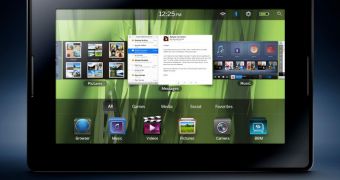On Monday, handset vendor Research In Motion announced the release of its own tablet PC, the BlackBerry PlayBook, which runs under a new platform, the BlackBerry Tablet OS, based on technology by QNX Software Systems. A closer look at the Tablet OS is offered by Dan Dodge, co-founder and CEO of this company, via an interview posted on BlackBerry Developer's blog.
First off, we should note that the company's QNX Neutrino OS is already popular in various applications, offering a series of highly appreciated features, including reliability, scalability, performance, portability.
The solution also offers enhanced flexibility, and this should prove to be one of the most important features of the BlackBerry Tablet OS.
As Dan Dodge states, one can come up with some highly appealing software solutions for BlackBerry PlayBook using Adobe Mobile AIR, Adobe Flash, and HTML5.
“Of course, since the BlackBerry Tablet OS seamlessly pairs with BlackBerry smartphones, the types of things that customers have come expect in terms of enterprise-grade mobility features are available to BlackBerry Tablet OS applications,” he says.
The slate's flexibility translates in support for additional runtime frameworks and virtual machines, which enables it run a virtual machine which would run BlackBerry 6 Java applications.
“Under the hood, we have a 1GHz dual core processor, accelerated 3D graphics, HD video, and a 7″ multi-touch widescreen. Think of the potential for applications that can combine all these technologies,” Dodge notes.
Another appealing feature of the new tablet PC, powered by the QNX Neutrino architecture, is support for true multitasking on multicore hardware, which would enable multiple apps to run at the same time, while still delivering enhanced performance levels.
When it comes to application development, the new operating system offers app builders the possibility to use standard Adobe products such as Flash Builder to come up with software solutions, while being able to debug straight on the new BlackBerry PlayBook tablet.
“For applications that require access to the native OS environment, developers can develop and port C/C++ applications and also take advantage of the QNX Momentics Tool Suite, which is based on the Eclipse standard,” Dodge stated.
He also added that the new BlackBerry Tablet OS offers “built-in interfaces to integrate the rich graphical application environment with underlying native code.”

 14 DAY TRIAL //
14 DAY TRIAL //